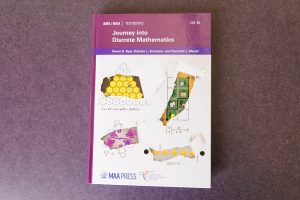Sometimes the thrill of mathematics doesn’t come from the question, but from a beautiful solution.
Consider the approach Eastern Mennonite University math professor Owen Byer took when deciding which problems to include in the new textbook he co-authored with math-professor-turned-vice president and academic dean Deirdre Longacher Smeltzer, and Regent University professor Kenneth Wantz:
“In my own view,” he said, “either it should be a really interesting question, or – lacking that – the solution should be beautiful. Even average problems are worth including if the solution teaches you something.”
This November marked the publication of the long-anticipated – and, already, long-used – textbook Journey into Discrete Mathematics (Mathematical Association of America Press, 2018).
“This is definitely the best math textbook that I’ve ever used,” said sophomore Andrew Nord after a recent session of his discrete math class, which is the latest to use the – until now, pre-published – book. “It explains the concepts very fully and in a way that can be understood fairly easily.”
From the start
Byer, Smeltzer and Byer’s University of Delaware PhD advisor Felix Lazebnik began talking about writing Journey at about the same time the trio’s earlier textbook Methods for Euclidean Geometry (MAA, 2010) was published. All three had doctoral training in discrete math and had taught it many times, and “it seemed like a good second joint project,” Smeltzer said.

A year into the writing of Journey, however, Lazebnik needed to bow out – but generously granted permission for materials that he had developed to remain in the textbook. Byer and Smeltzer then invited Wantz, a former grad school colleague of Byer’s, to join them, and the new trio continued even as a new wrinkle developed: Smeltzer’s transition to being undergraduate dean left her little time to focus on the textbook. While each author ultimately made similar contributions, she said, Byer provided leadership and did “more of everything, especially generating problems and solutions.”
Once drafted, Journey entered what Byer modestly dubbed “a long process” of revising and polishing. For Smeltzer, that process posed the biggest challenge of writing Journey, second only to her limited time: “It’s hard to see something with fresh eyes when you’ve been working on it for a long time.”
There was a beautiful way to help with that problem, however.
A beautiful solution: students
As early as half a decade ago, Byer and his colleagues at EMU began using Journey in the classroom, first in pdf form and later – including this fall, even as the book was heading to press – in three-ring binders in Professor Daniel Showalter’s discrete math class.
Doing that had distinct benefits: Students could learn from a textbook grounded in experienced educational practice. Plus, students’ fresh eyes would help tease out what needed better explanation – and they’d find mistakes, discoveries that were often rewarded with bonus points.
Another of Showalter’s students, sophomore Silas Clymer, remembers – with a note of satisfied glee in his voice – finding a misleading hint in a homework problem. But more importantly, “It’s definitely cool having the writer of the book downstairs in an office,” he said. “You can go to talk to him if you need to.”
Showalter often teaches using a flipped classroom model, a model that depends on having a clearly written textbook: students learn concepts on their own from the textbook, and show up to class for answers to their questions and content-related activities. Even prepublicaton, he said, the evolved Journey proved an effective flipped-classroom text.
“It’s very clear,” Showalter said. “It’s rigorous and precise, and has plenty of examples.”
His students agree.
“I’ve never really learned from a textbook before,” said first-year student Jeremiah Yoder after a recent class period during which Showalter guided students in applying newly learned concepts to solve a variety of famous problems. “The textbook was always supplementary. But with this textbook, I feel like I’m on course without assistance, so I’m learning well.”
“We really don’t need a teacher,” his classmate Isaac Andreas joked. “That’s why we can just play math games in class every day. I mean, we spend a little bit of time on the content during class, but then we go off and [solve fun problems]. It’s still math.”
‘Exquisite and engaging’
Byer expects Journey to be adopted more widely than the “niche” Methods, as discrete math is taken not only by math majors but also students in computer science, and since MAA Press is now an imprint of the American Mathematical Society.
The publisher describes the text’s exposition as “exquisite and engaging,” with “detailed descriptions of the thought processes that one might follow to attack the problems of mathematics. The problems are appealing and vary widely in depth and difficulty.”
That’s no surprise, of course, taking into account the authors’ cumulative expertise from decades of teaching – and loving the beauty of – math.

Congratulations on the textbook publication. It almost entices me to study math again at age 79!
Congratulations! I know that writing a book is a huge undertaking – yes, I too have done it. Two separate Editions of “The 3-D Global Spatial Data Model” are in the EMU library. As a side note, after I retired from teaching in 2010, I audited 6 different courses in the Computer Science Dept. The text book for one of them was 4th Edition of “Discrete Mathematics with Applications” by Susanna S. Epp. Good “stuff” and essential for spatial data applications. My traditional engineering education relied heavily on geometry and calculus. That is great but, this point could be argued, matrices and discrete math currently eclipse that priority.
Congratulations, Deirdre!